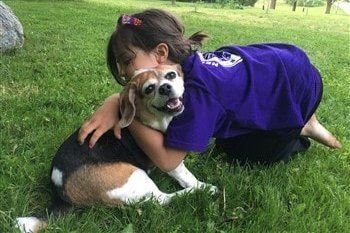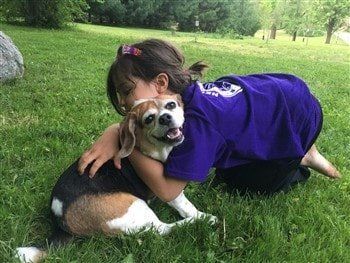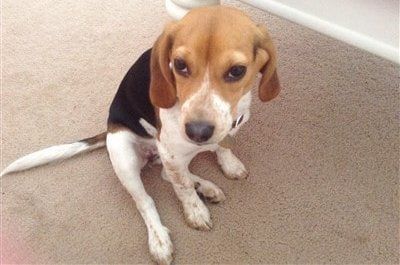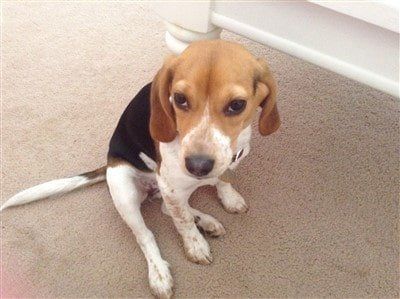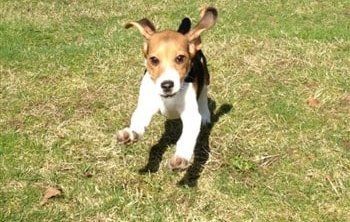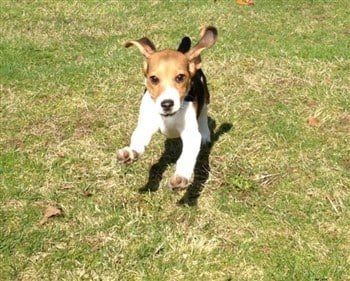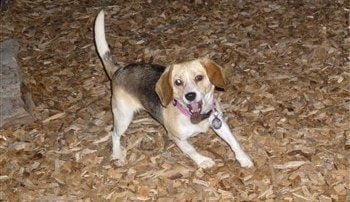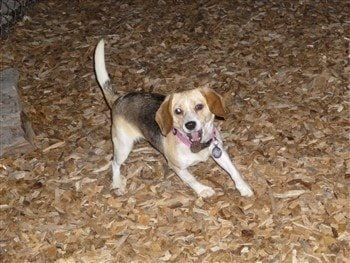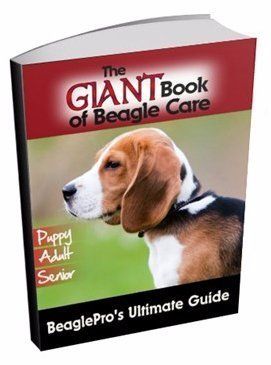When a Beagle is Hyper
Overview
The Beagle is many things. He is smart, curious, friendly, great with children, absolutely loyal, and makes for a fantastic canine family member. However, one thing that he is not, is low-energy.
Beagles like to be active. They love to trot, run, play and jump. This said, many owners - particularly of young Beagles - find that their puppy or dog is extremely hyper. And wonder, when will he calm down?
The most prevalent issue are Beagles that look mature, but don't act it. In other words, they are getting close to their adult size or are already there, but are behaving like young pups.
Another common thread are fully adult Beagles having trouble containing and properly expressing their inner drive to be active, acting overly hyper at times deemed inappropriate.
There are 2 pieces of good news:
1) Most Beagles will indeed calm down as they mature and 2) There are steps you can take to help a hyper Beagle mellow out a bit, no matter his age.
In this section, we'll cover all of the details about this.
Hyperness Levels of Beagles By Age
Here is what you can expect with the typical Beagle:
Young puppy 2 to 4 months: Moderately hyper.
Everything is new. Focus is poor. He'll jump from one thing to the next without much thought. He can do okay without extended outdoor play; however, that will end very soon.
Puppy 4 months to 12 months: Very hyper.
This is the stage where you will see the most hyper behavior; though, without proper methods to vent, even adults can be this way. Beagles that are not given ways to release pent up energy can become very frustrated and even frenzied.
12 to 18 - 24 months: A turning point, moderately hyper.
This is when owners most often question if their Beagle is acting normal. He has the body of an adult (or just about) but still has puppy-like tendencies that make him want to play every second, demand attention from you and generally have trouble just chilling out. It is at this point that the emotional needs to catch up to the physical. Not to worry, as long as he's receiving what he needs, he will indeed calm down.
24 months +: Somewhat hyper, but controlled. At the age of 2, and especially by 2.5 years old, things will change. Both his body and his mind are that of an adult. By now you know your Beagle, he has a good routine of both exercise and rest. He has plenty of toys to keep himself occupied and he often mimics the vibe of the household. If everyone is relaxing, he will too. If people are busy and things are going on, he wants to join in on the fun. This said, adult Beagles can find life to be frustrating if their true needs are not met.
8+ years: Slightly to not at all hyper.
The senior Beagle
has seen it all, smelled it all and is satisfied that he's run, explored and taken in the world. As these senior years go by, a Beagle will enjoy the familiar and not need to see what else is out there. He's happy relaxing near you, or alone in his area. To slow the loss of muscle mass and keep the heart strong, do continue to take him for walks, albeit at a slower pace than his younger counterpart.
Hyper Beagle Puppies
It is normal and expected for young Beagle puppies to be exceptionally hyper. They have the whole world to explore and their nature tends to make them excited about just about everything that they see. They have a very high level of curiosity and there is nothing that is left behind to explore.
During the first months in a new home, it's normal for Beagle puppies to explode with energy and then crash to take a nap. It can be quite a roller coaster.
Tips: 1) You'll find that crating a Beagle puppy is rarely a good choice.
It is just too confining for this breed.
And feeling confined can cause a Beagle to get so revved up that he's twice as hyper than otherwise expected. When you're still in the housebreaking stage and you can't keep an eye on your Beagle, it's best to keep him in a gated area where he has some room to move.
2) Offer breaks from play.
Many times, a Beagle pup will just keep going. Like the Energizer Bunny, he'll never stop. However, in some cases this is because of extended interaction with humans and particularly with children (who themselves can keep going!) long passed the time that he could have had a break.
For this reason, do offer a break by leading him to his bed or encouraging him to rest on the sofa with you, to see if that is what he truly wants.
3) Have a 'retreat' area.
Whether it's a bed placed in a quiet part of the living room or one within his gated area (gate open when you're home and can supervise), be sure that your Beagle knows where to go if he wants to take a break.
4) Two weeks passed the mark when a Beagle pup has all of his puppy shots,
it's time to get out of the house! Aim for at least 1 hour of outdoor activity per day. This can be fetch, controlled running, walks, anything as long as you're with him and he's moving. If a pup is very hyper, 3 20-minute sessions often work better than 2 30-minute ones.
5) Start teaching commands.
This sets the foundation for good behavior, reinforces proper hierarchy and helps to cultivate the art of focusing on a task. It is also a great way to help a puppy gain self-confidence and will, in the end, help you better control your Beagle in all situations.
Start with 'Sit' and then move through all basic commands: Stay, down, come, fetch and the all-important heel.
Puppies as young as 8 weeks old can start learning. When a Beagle is young, just do short 10 minute sessions. Increase as his ability to focus increases.
By the time he reaches the 1-year mark, he will have all commands down and this will make life a bit easier.
Snoopy Girl, at 4 months old
Photo courtesy of Lori
Hyper Adolescent Beagles and Hyper Adult Beagles
From 12 months old right up until the 2 year mark, Beagles are at their most hyper stage. And this is not necessarily a bad thing. All it really takes is proper funneling of all of that energy.
For adults (2+ years) feelings of frustration can build up and be expressed with a sort of crazed behavior if the dog does not have a healthy outlet. What worked when he was younger, may need to stepped up a notch now.
Here are some tips:
Snoopy
Photo courtesy of Silvia Martinelli
1) Reassess Exercise
- Everyone gets busy and it's not always easy to fit everything into one day. However, it's really important that a Beagle be able to properly release his energy. If he is stifled in this way, you can't expect him to reel in his hyperness and remain calm.
If your Beagle is having trouble containing himself, reevaluating how often you take him out is part of the solution.
And in some instances, such things as the weather (long cold winters) are getting in the way. If so, take steps to winterize your Beagle
and
yourself (biggest mistake is owners not prepped for the cold).
Maybe you've been sticking to a routine for so long, that you didn't realize that his needs changed...
or maybe as he's gotten older (and more able), you have not increased his activity to have a longer duration or to be more challenging (see next tip).
2) Add some challenges
- For hyper Beagles, it is rare that just a walk will suffice. One option is to obtain a long lead (30 or better yet 50 feet) to allow him the freedom to run. And not just run, let him bound up a hill, let him run over obstacles. Tip
- Before allowing him to take off running, have him obey a 'Sit' and then give the command of 'Okay!' to release him.
You can also set up some jumps, hoops and tunnels in your yard (if you have the space) and teach him how to maneuver over and through them. Beagles love this!
After these types of sessions, he will be more than happy to relax inside with you, his energy released in a healthy way.
3) Allow time for your Beagle to do what Beagles do best. Born with super strong scenting abilities, the Beagle breed is one of the best hunting hounds
that exist. And while most Beagles are family pets and not part of a hunting pack, they still have that instinct.
Hyper behavior can, at least in part, be attributed to having their instinct repressed.
For this reason, you may wish to schedule 'scenting sessions'. This can be done either indoors or out, though if the weather is cooperative, outside is best.
One way to provide an interesting challenge that allows a Beagle to test and then hone his ability is to use trace scents.
Jin-Jin, at 2 years old
Photo courtesy of Terry Frady
There are quite a few ways to go about doing this; however, one of the easiest is as follows:
1.
Choose the object that you wish for your Beagle to find. Best is a sturdy rubber toy, like a Kong.
2.
Choose the scent. Bacon grease works very well for this. You do not need a lot at all - just the drippings from one piece will more than do.
3.
Swipe a bit of your chosen scent onto the object.
4.
Dab a bit of it also onto the corner of a paper towel.
5.
Starting off with an easy-to-find spot, hide the object. Have your Beagle obey a 'Sit', allow him to sniff the paper towel and give a 'Find' command. If needed, bring him closer to the area, allowing his first hunt to be relatively easy.
6.
As he starts to get a feel for the game, you can make this gradually more challenging. First 10 feet away, then 20, then 30. First behind a tree, then under a rock. If you use the long 50-foot leash as described earlier, your Beagle can exert a huge amount of rushed energy, chasing after the trail. Afterward, he'll be much more apt to relax after a interesting 'day of work'.
4) Have the right toys
- If your Beagle's toy essentially remain untouched or if you find yourself saying that your Beagle is hyper but never wants to play with toys, this is most likely because you need to have the right toys. For Beagles that need to release they pent-up energy and learn better control over hyper behavior this includes toys for independent play, sniff toys, fetch toys and chewing toys.
Chews
- Often, a Beagle will be feeling restless and antsy not because he needs to be physically active but because he needs to chew. It's a natural urge for dogs of all ages (bar some seniors). It's a healthy way to release frustration; working the jaws can bring a dog a sense of calm. Be sure to choose chews that stand up to sharp teeth and high-energy chewing.
To make outdoor activity more fun
- While some dogs are not too picky and will chase after anything that is thrown, many need something truly engaging, like a ball-launcher.
To encourage play
- There will, of course, be times that you cannot be right beside your Beagle; either he'll be home alone
or you'll be busy with other things. And this is when toys that have singing or voices or otherwise make noise can be helpful. When a puppy or dog feels that he's getting responses from a toy, he will spend a lot more time engaged with it.
Mental stimulation
- While the Beagle breed does
need to release his physical energy, mental energy plays a role as well. Canines are wonderfully intelligence creatures and sometimes, if a Beagle is bored and has no growth intellectually, this can manifest physically. He may pace, whine, act out or otherwise seem unsettled.
For this reason, activities which engage a Beagle's mind can be a great help, like snuffle mats or puzzle toys.
True Hyperkinesis
99.99% of hyper Beagles will be that way due to maturity level and due to being an active breed with a need to release energy. However, there is a rare medical condition, hyperkinesis, that causes extreme hyper behavior.
With this, there are often other clinical signs including: rapid heart rate, rapid breathing, excessive vocalization, aggression, and/or pure muscle tone. Dogs that suffer from this condition can be 'set off' by even the tiniest of triggers. For example, heavy footsteps or the sound of a door closing can cause the dog to enter a frenzied state.
There is testing that can be performed to either rule out or confirm hyperkinesis. Most often, this is done over the course of a 2 to 3 day stay at an animal hospital. During that time, the dog's vitals will be monitored, both when he is relaxed and when stimuli is introduced.
If a dog is found to have hyperkinesis, supplements shown to have promise include L-theanine, GABA and valerian root. Medications such as D-amphetamine (used to treat human ADHD) has been shown to work rather well.
A Final Word
This is a very high-energy dog breed, and is definitely not
the type of dog that can always just 'be there'. While you can
have plenty of time with your Beagle relaxed by your side and taking it easy with the family, this is best accomplished by making sure that you meet his needs for both physical and mental release.
Did you catch these topics?
The Beagle VS Other Breeds
- An interesting look at how the Beagle compares to other breeds.
What do Do if a Beagle Keeps Jumping on People
- Though a Beagle will do this due to his high level of playfulness and energy, it can of course be disturbing to guests in your home.
What to Do When a Beagle Won't Listen
- There are 3 basic reasons why this may be happening; luckily it can be resolved.
Beagle Bad Breath
- The top reasons why a Beagle's breath may stink and exactly how to fix it.
Beagle Nose Issues
- All nose related problems including dryness, peeling and cracking. Prevention and treatment.

